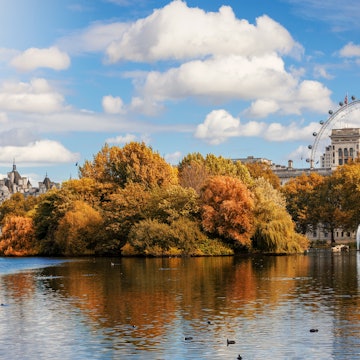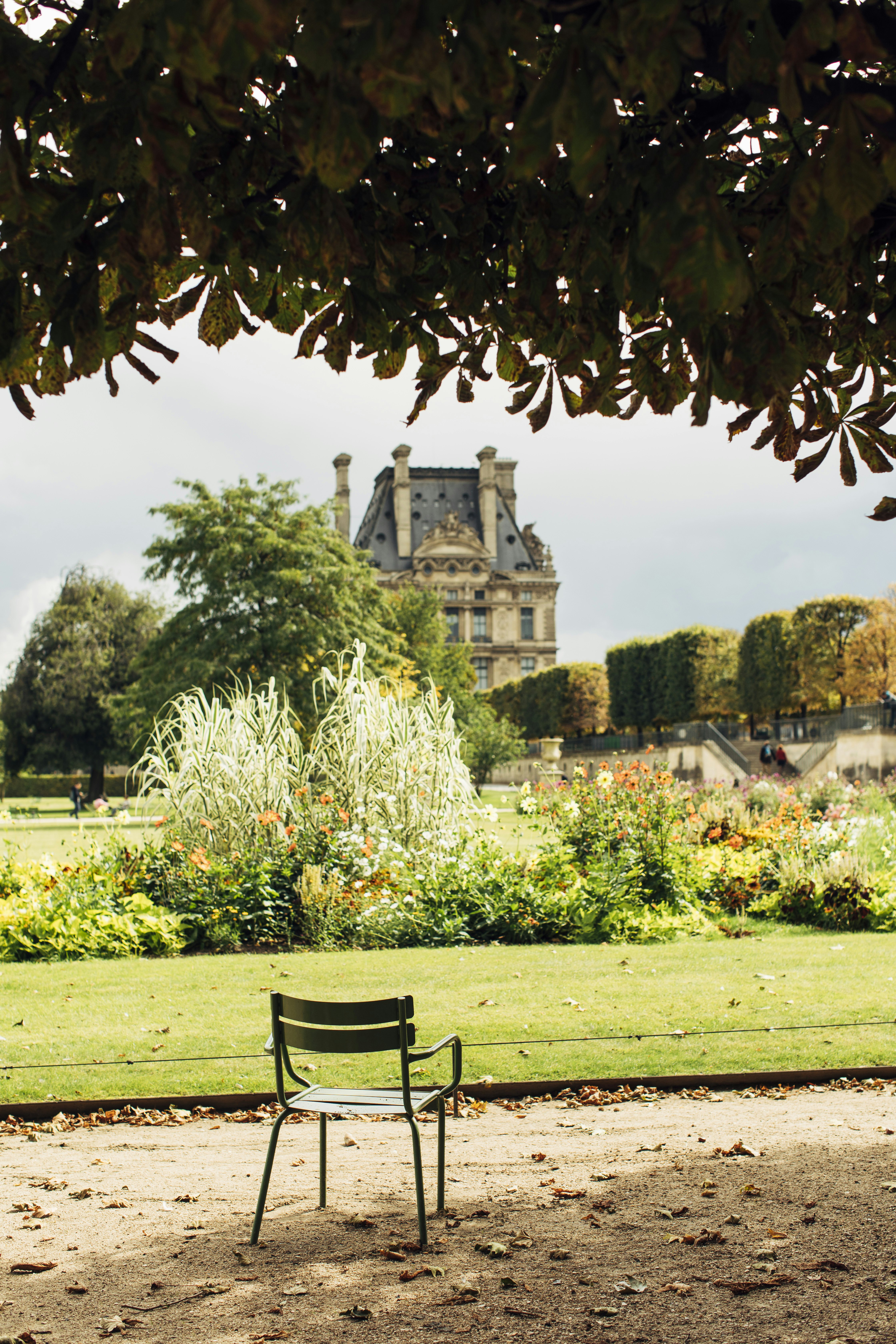

Beautiful autumn day with People enjoying themselves at Jardin des Tuileries in Paris © Getty Images
With exceptional museums, glamorous shops and tantalizing restaurants, it’s easy to forget that one of the best ways to enjoy Paris is outdoors. The city is filled with historic parks, gardens and green spaces where travelers can relax like a Parisian.
From the manicured perfection of Jardin du Luxembourg—ever popular with locals and tourists alike—to the urban wonders of Promenade Plantée, Parisian parks will leave you in awe. This is where to find the best parks in Paris.
Editor's note: during COVID-19 there may be additional travel restrictions. Check the latest guidance in France before planning a trip, and always follow local government health advice.
Jardin du Luxembourg
The city's most popular park, the Jardin du Luxembourg, offers a snapshot of Parisian life. Couples stroll through the chestnut groves. Children chase wooden sailing boats around the octagonal pond and laugh at the antics of engaging marionettes.

Old men play rapid-fire chess with cherished pieces at weathered tables. Students pore over books between lectures. Office workers snatch some sunshine, lounging in iconic sage-green metal chairs. Musicians strike up in the bandstand. Joggers loop past stately statues. And friends meet and make plans to meet again.
Parc des Buttes-Chaumont
Buttes Chaumont is one of the city’s largest green spaces, with landscaped slopes hiding grottoes, waterfalls, a lake and even an island topped with a temple to Sibylle. Once a gypsum quarry and rubbish dump, it was given its present form by Baron Haussmann in time for the opening of the 1867 Exposition Universelle. The tracks of the abandoned 19th-century Petite Ceinture railway line, which once circled Paris, run through the park.

It’s a favourite with Parisians, who come here to practise tai chi, take the kids to a puppet show, grab a sundowner and pizza at trendy Le Pavillon Puebla or simply to relax with a bottle of wine and a sundown picnic.
Parc Monceau
Marked by a neoclassical rotunda at its main boulevard Courcelles entrance, beautiful Parc Monceau sprawls over 8.2 lush hectares. It was laid out by Louis Carrogis Carmontelle in 1778–79 in English style with winding paths, ponds and flower beds. An Egyptian-style pyramid is the only original folly remaining today, but other distinctive features include a bridge modelled after Venice's Rialto, a Renaissance arch and a Corinthian colonnade. There are play areas, a carousel and scheduled puppet shows for kids.

Throughout the park, look out for statues including those depicting composers Frédéric Chopin and Charles-François Gounod (known for 'Ave Maria'), and writer Guy de Maupassant. In 1797, André-Jacques Garnerin made history by landing the world's first parachute jump (from a hot-air balloon) in the park.
Jardin des Tuileries
Filled with fountains, ponds and sculptures, the formal 28-hectare Tuileries Garden, which begins just west of the Jardin du Carrousel, was laid out in its present form in 1664 by André Le Nôtre, architect of the gardens at Versailles. The Tuileries soon became the most fashionable spot in Paris for parading about in one’s finery. It now forms part of the Banks of the Seine Unesco World Heritage site.

The axe historique (historic axis), the western continuation of the Tuileries’ east–west axis, follows the av des Champs-Élysées to the Arc de Triomphe and, ultimately, to the Grande Arche in the skyscraper district of La Défense. At the far western end of the gardens are two museums, the Musée de l'Orangerie and the Jeu de Paume.
Promenade Plantée
The disused 19th-century Vincennes railway viaduct was reborn in 1993 as the world's first elevated park, planted with a fragrant profusion of cherry trees, maples, rose trellises, bamboo corridors and lavender. Three storeys above ground, it provides a unique aerial vantage point on the city. Along the first, northwestern section, above av Daumesnil, art-gallery workshops beneath the arches form the Viaduc des Arts. Staircases provide access (lifts here invariably don't work).

Officially the Coulée Verte René-Dumont, it's better known as the Promenade Plantée. Waking southeast, look out for the spectacular art deco–style police station at the start of rue de Rambouillet, which was built in 1991 and is topped with a dozen huge, identical telamones (male figures used as pillars) based on Michelangelo's Dying Slave.
The viaduct later drops back to street level at Jardin de Reuilly (1.5km); it’s possible to follow it all the way (4.5km) to the Bois de Vincennes. This latter section can also be done on a bike or in-line skates. A 1.7km section of the former Petite Ceinture, the steam railway line that encircled central Paris from the late 19th century until the line closed to passenger trains in 1934 and freight trains in the early 1990s, intersects the promenade 200m north of square Charles Péguy.
Parc de la Villette
Spanning 55 hectares, this vast city park is a cultural centre, kids playground and landscaped urban space at the intersection of two canals, the Ourcq and the St-Denis. Its futuristic layout includes the colossal mirror-like sphere of the Géode cinema and the bright-red cubical pavilions known as folies. Among its themed gardens are the Jardin du Dragon (Dragon Garden), with a giant dragon’s tongue slide for kids, Jardin des Dunes (Dunes Garden) and Jardin des Miroirs (Mirror Garden).

Events are staged in the wonderful old Grande Halle (formerly a slaughterhouse – the Parisian cattle market was located here from 1867 to 1974), Le Zénith, the Cabaret Sauvage, the Conservatoire National Supérieur de Musique et de Danse, and the Cité de la Musique – Philharmonie de Paris complex.
Château de Versailles Gardens & Park
While on the outskirts of Paris, Versailles remains one of the most iconic green spaces near the French capital. The section of the vast gardens nearest the palace, laid out between 1661 and 1700 in the formal French style, is famed for its geometrically-aligned terraces, flower beds, tree-lined paths, ponds and fountains. The 400-odd statues of marble, bronze and lead were made by the most talented sculptors of the era. The English-style Jardins du Petit Trianon are more pastoral and have meandering, sheltered paths.
Oriented to reflect the sunset, the Grand Canal, 1.6km long and 62m wide, is traversed by the 1km-long Petit Canal, creating a cross-shaped body of water with a perimeter of more than 5.5km. On the southwestern side of the palace, the Orangerie, built under the Parterre du Midi (southern flowerbed), shelters tropical plants in winter.

The gardens’ largest fountains include the 17th-century Bassin de Neptune, a dazzling mirage of 99 spouting gushers 300m north of the palace, whose straight side abuts a small pond graced by a winged dragon (Grille du Dragon). On the same days as the Grandes Eaux Musicales fountain displays, the Bassin de Neptune flows for ten minutes.
At the eastern end of the Grand Canal, the Bassin d’Apollon was built in 1688. Emerging from the water in the centre is Apollo’s chariot, pulled by rearing horses.
Jardin des Plantes
Founded in 1626 as a medicinal herb garden for Louis XIII, Paris’ 24-hectare botanic gardens – visually defined by the double alley of plane trees that runs the length of the park – are an idyllic spot to stroll around, break for a picnic (watch out for the automatic sprinklers!) and escape the city concrete for a spell. Three museums from the Muséum National d'Histoire Naturelle and a small zoo, La Ménagerie, add to its appeal.

Other attractions include peony and rose gardens, an alpine garden, and the gardens of the École de Botanique, used by students of the school and green-fingered Parisians. The beautiful glass-and-metal Grandes Serres, a series of four greenhouses, have been in use since 1714; several of Henri Rousseau's jungle paintings, sometimes on display in the Musée d'Orsay, were inspired by his frequent visits here.
Bois de Boulogne
On the western edge of Paris just beyond the 16e, the 845-hectare Bois de Boulogne owes its informal layout to Baron Haussmann, who was inspired by Hyde Park in London.

In the south are two horse-racing tracks, the Hippodrome de Longchamp for flat races and the Hippodrome d’Auteuil for steeplechases. The woods are also home to the Stade Roland Garros, where the French Open takes place. Be aware that the Bois de Boulogne, especially along the allée de Longchamp, can be frequented by sex workers looking for clients.
Bois de Vincennes
In the southeastern corner of Paris, Bois de Vincennes encompasses some 995 hectares. Originally royal hunting grounds, the woodland was annexed by the army following the Revolution and then donated to the city in 1860 by Napoléon III. A fabulous place to escape the Parisian concrete, Bois de Vincennes also contains a handful of notable sights, including a bona fide royal château, Château de Vincennes, with massive fortifications and a moat.

Paris' largest, state-of-the-art zoo, the Parc Zoologique de Paris, is also here, as is the magnificent Parc Floral de Paris, a botanical park with exciting playgrounds for older children. The wood also has a lovely lake, with boats to rent and ample green lawns to picnic on.
You may also like:
20 free things to do in Paris
The 7 best day trips from Paris
10 things you might not know about the Eiffel Tower
















